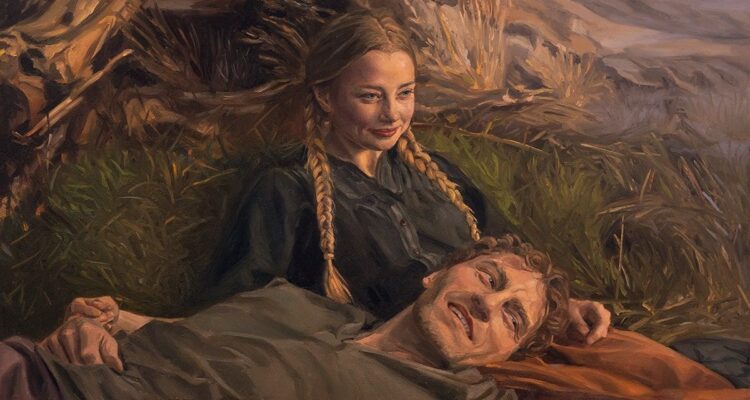
Mit Loving Vincent gelang DK und Hugh Welchman eine absolute Sensation. Der Film, der mit animierten Gemälden das Leben von Vincent van Gogh erzählte, lief auf zahlreichen Festivals und wurde für einen Oscar nominiert. Nun meldet sich das Ehepaar mit einem zweiten Animationsfilm zurück. Das Flüstern der Felder (Kinostart: 12. September 2024) basiert auf dem mit einem Nobelpreis ausgezeichneten Roman Die Bauern von Władysław Reymont und erzählt die Geschichte einer jungen Frau, die in einem polnischen Dorf Ende des 19. Jahrhunderts an einen reichen Bauern verheiratet werden soll. Wir haben DK Welchman bei der Deutschlandpremiere beim Filmfest München getroffen und mit ihr über die Arbeit am Film gesprochen.
Meine erste Frage ist: Warum wolltest du den Film machen? Was hat dich daran interessiert, eine Adaption von Die Bauern zu drehen?
Dieses Buch ist in Polen Pflichtlektüre für das Gymnasium und soll daher von Teenagern gelesen werden. Natürlich lesen sie es nicht, weil es 800 Seiten umfasst und sehr lange Beschreibungen enthält. Ich sage nicht, dass es langweilig ist oder so, aber wenn man 17 ist, ist es wirklich nicht leicht zu lesen, weil man zu sehr mit anderen Dingen beschäftigt ist und nicht genug Geduld hat. Ich denke, man muss ein bisschen erwachsen werden. Ich habe auf dieses Buch zurückgegriffen, als ich für Loving Vincent gemalt habe. Ich höre mir bei der Arbeit sehr gerne Hörbücher an, besonders wenn ich künstlerisch tätig bin. Also habe ich mir dieses Hörbuch in meinen 30ern angehört und das war ein sehr großer Unterschied. Mir wurde klar, dass es eine so unglaubliche Literatur ist, die diese wunderschöne Sprache hat, eine sehr malerische Sprache. Die 10-seitige Beschreibung der Natur war für mich sofort ein Grund, einen Animationsfilm zu machen, denn in einer kurzen Szene mit dem Gemälde kann man fast die gleichen Gefühle hervorrufen, die der Autor hervorzurufen versuchte, als er auf den Seiten die Natur von Wörtern beschrieb . Aber auch die Geschichte über ein kleines Dorf in Polen vor 130 Jahren gefällt mir sehr gut. Natürlich denkst du vielleicht: Wie ist das für Menschen von heute relevant und warum? Wer interessiert sich für das Leben von Bauern aus einem polnischen Dorf vor 130 Jahren? Aber all diese Themen sind sehr aktuell und das hat mich beeindruckt. Außerdem wollte ich unbedingt mehr weibliche Geschichten erzählen. Meiner Meinung nach hatte das in unserem Land so wichtige Buch eine Neuadaption mit einer völlig anderen Sichtweise verdient.
Warum ist dieses Buch deiner Meinung nach in Polen so wichtig?
Ich denke, dass es aus dem gleichen Grund mit dem Nobelpreis ausgezeichnet wurde, weil es ein Meisterwerk in Bezug auf die Beschreibung der menschlichen Natur und aller Emotionen ist. Das Buch zeigt Menschen, die genau wie wir sind: Liebe, Leidenschaft, Eifersucht, Gier. All diese Emotionen sind sehr aktuell. Es gibt viel Wärme und Sympathie für diese Charaktere. Und ich denke, die Geschichte selbst ist sehr fesselnd, diese ganze Dreiecksliebesgeschichte. Doch der Roman zeigt auch eine Welt, die es nicht mehr gibt. Es zeigt die Bauern und das Leben der damaligen Zeit. Es gibt historische und politische Themen, weil Polen geteilt war. Aber hauptsächlich geht es um die menschliche Natur.
Hatten du jemals Zweifel an dem Projekt, eben weil es so ein Nationalschatz ist?
Ich hatte Zweifel, als mir klar wurde, dass sich 800 Seiten des Buches nicht so einfach auf 100 Seiten des Drehbuchs übertragen lassen. Somit war klar, dass ich Teile des Buches herausstreichen musste. Und mir wurde klar, dass einige Leute es hassen werden, wenn ich die Geschichte auf meine Art kürze und bearbeite. Manche Leute werden denken, dass ich etwas Wichtiges herausgenommen habe. Dabei habe ich wirklich versucht, der Geschichte gerecht zu werden, musste mich aber natürlich auf die Haupthandlung konzentrieren, die ich gewählt habe. Nicht nur am Anfang, sondern auch während der Produktion gab es viele Zweifel und Probleme. Wir hatten eine Hürde nach der anderen.
Was war dabei die größte Herausforderung?
Die größte war meiner Meinung nach der Umfang und der Stil. Wir wussten irgendwie, dass es größer und schwieriger werden würde als Loving Vincent. Aber wir wussten nicht, wie viel mehr. Und so haben wir uns ein wenig verschätzt. Loving Vincent war ein sehr kleiner, intimer Film mit größtenteils stillstehenden Charakteren. Und hier gibt es all diese Gruppenszenen, Tänze und Kämpfe. Aber auch die Kostüme, deren Malen ein Albtraum war. Wir wollten all die Emotionen einbringen, die uns die Schauspieler vermittelten, all die brillanten Darbietungen. Das war so viel schwieriger, als wir erwartet hatten, sodass wir die Zeit bis zur Umsetzung hätten verlängern müssen. Und da wir keine Zeit hatten, haben wir das Budget kräftig aufstocken müssen und haben es überzogen. Das war zu der Zeit, als die Inflation einsetzte, und zwar in allen Ländern, in denen wir produzierten. Also ja, das war eine Katastrophe. Eine weitere Hürde war der russische Angriff auf die Ukraine, weil wir ein Studio in Kiew hatten und das Studio schließen mussten.
Dann noch eine Frage zu der Umsetzung. Es traten echte Schauspieler und Schauspielerinnen auf. Aber wie sieht es mit den Hintergründen und Kostümen aus? Waren die echt oder wurden sie von Grund auf erfunden?
Wir haben alles gedreht, hauptsächlich Schauspieler in Kostümen im Studio. Also über Greenscreens. Wir hatten einige Sets, etwa wenn sie über den Markt läuft, aber meistens drehten wir vor Greenscreens. Wenn es in einer Szene eine Landschaft gibt, dann haben wir in dieser Szene definitiv einen Greenscreen verwendet. Wir haben in der Postproduktion und Animation viel hinzugefügt. Das war ein lustiger Teil und bedeutete, dieses Material zusammenzustellen. So zum Beispiel die Landschaften, die wir geschaffen haben, die Animationen der Tiere wie der Vögel, das waren hauptsächlich Animationen in CGI. Wir hatten eine wirklich tolle Engine namens Unreal, die ursprünglich für Videospiele verwendet wurde. Die Bilder wurden auf eine Leinwand projiziert und die Maler malten von dieser, so wie Maler manchmal von einer Fotografie malen. Als uns klar wurde, wie schwer es ist und wie lange es dauert, war klar, dass wir nicht 12 Bilder pro Sekunde wie bei Loving Vincent schaffen können. Also fingen wir an, 8 bis 6 zu malen und dann die Zwischenschritte in Photoshop mit digitaler Farbe zu malen.
Wie viele Leute haben für den Film gemalt?
Öl etwa 100 und dann noch einmal etwa 50 bei Photoshop.
Das Flüstern der Felder war ein langwieriges Projekt. Welcher Teil hat am längsten gedauert?
Es dauerte weniger als ein Jahr, das Drehbuch mit Korrekturen und Beratungen zu schreiben. Das Gemälde dauerte etwa zwei Jahre. Der Schnitt war natürlich sehr lang, aber die Dreharbeiten waren aufgrund der Corona-Krise sehr lang und wir mussten die Dreharbeiten abbrechen. Oh, und da ist noch etwas, das einige Zeit gedauert hat: Wir hatten drei verschiedene Enden. Aber das war meine Schuld, weil mir das Ende jedes Mal nicht gefiel und es so wichtig für mich war. Also mussten wir zurück ins Studio und den Schluss drehen. Ich glaube aber, dass das Malen am längsten gedauert hat, da 150 Leute zwei Jahre lang gemalt haben.
Vielen Dank für das Gespräch!
(Anzeige)

